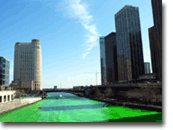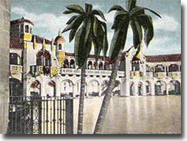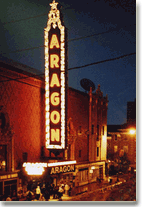Sep 20 2008
This Month’s Venue — Aragon Ballroom

Sweet Home, Chicago!
Currently ranked as the third-most populous city in the United States, Chicago was first discovered by European explorers, Marquette and Jolliet, in 1673. It’s name was taken from the Native American word shikaakwa, meaning water leek, a plant commonly found along the banks of the Chicago river. The Chicago of today is a dominant force in finance and industry. It’s musical heritage is no less impressive. The list of famous blues musicians who called the “Windy City” home at one time or another is impressive: Scrapper Blackwell, Big Bill Broonzy, Arthur Crudup, James Cotton, Bo Diddly, Willie Dixon, Howlin’ Wolf, Muddy Waters, and Buddy Guy to name but a few. Chicago was the destination of choice for many of the delta bluesman of the forties and fifties fleeing the South in the “Big Migration”. They took their southern folk music, electrified it, and transformed it into a unique sound called, “Chicago Blues”.
“This is the place where people just like myself came from the South to create new lives and a new kind of music. The generation just before mine came up here playing folk music. But soon they traded in their acoustic guitars for electric instruments. And when they plugged them in, they created a new, urban sound, that we call Chicago blues.”–Buddy Guy
Originally, black artists performed blues for black audiences in the predominantly black, Southside of Chicago in clubs like the Checkerboard Lounge or the 708 Club. The new sound could not be confined to the Maxwell Street area however, and as the music gained acceptance with the white audience, more and more blues clubs started popping up, particularly in the city’s predominantly white, Northside. Black musicians and white musicians were now playing that new, urban sound. It was a sound that would influence and guide many of the famous guitar slingers of the burgeoning rock culture from Mike Bloomfield to Eric Clapton to Jimmy Page to Irish legend, Rory Gallagher.
“My music is for the most part blues…There is more Chicago blues influence in the music than there is rock…one of the characteristics of Chicago blues, [is]its toughness. It has a street feel to it. It’s real tough and hard-driving. I like to get the same effect in my music.” –Rory Gallagher, Cleveland Scene
Rory played on Chicago Blues giant, Muddy Waters, historic “London Sessions” along with Stevie Winwood, Georgie Fame and Mitch Mitchell in 1972.
“It was a real honour. The whole thing has stuck in my memory like a video. I can plug it in at any time and replay it in my head. I only wish I could do it again with my experience now because Muddy taught me an awful lot during those sessions and I came out a much better player than I went in…They were magical nights”–Rory Gallagher, Hot Press 1992
 Like many other major U.S. cities, Chicago has a large Irish-American population. By 1860 it was the fourth largest Irish city in America, but unlike their counterparts in New York, Boston, and Philadelphia, they have wielded tremendous political power disproportionate to their numbers. Chicago’s twelve Irish mayors have governed for more than 80 years, and on St. Patrick’s Day, the Chicago river is briefly turned green to honor the city’s Irish ethnicity. And what better way to honor the Irish than with a Rory Gallagher concert at one of Chicago’s finest nightclubs, the Aragon Ballroom!
Like many other major U.S. cities, Chicago has a large Irish-American population. By 1860 it was the fourth largest Irish city in America, but unlike their counterparts in New York, Boston, and Philadelphia, they have wielded tremendous political power disproportionate to their numbers. Chicago’s twelve Irish mayors have governed for more than 80 years, and on St. Patrick’s Day, the Chicago river is briefly turned green to honor the city’s Irish ethnicity. And what better way to honor the Irish than with a Rory Gallagher concert at one of Chicago’s finest nightclubs, the Aragon Ballroom!
 Considered one of the “world’s most beautiful ballrooms,” Chicago’s Aragon Ballroom was built in 1926 as a venue for ballroom dancing, and quickly became a focal point for the dance hall culture. The ballroom was designed by Huszagh & Hill for the Karzas brothers at a cost of over 2 million dollars, and featured a huge floating dance floor, surrounded by archways of Moorish design with Corinthian columns supporting fanciful facades of towers and balconies, palm trees and terra cotta roofs, making it look like the courtyard of a 15th century spanish palace.
Considered one of the “world’s most beautiful ballrooms,” Chicago’s Aragon Ballroom was built in 1926 as a venue for ballroom dancing, and quickly became a focal point for the dance hall culture. The ballroom was designed by Huszagh & Hill for the Karzas brothers at a cost of over 2 million dollars, and featured a huge floating dance floor, surrounded by archways of Moorish design with Corinthian columns supporting fanciful facades of towers and balconies, palm trees and terra cotta roofs, making it look like the courtyard of a 15th century spanish palace.
 By the 1960 however, ballroom dancing had reached its nadir and the Aragon sought other ways to regain its audience, including attempts to use it for roller skating, boxing matches, and as a discotechque. Finally in 1970, promoter Michael Butler of American Tribal Productions brought monster rock shows to the Aragon. Top performers like The Doors, the Kinks, Jethro Tull, The Byrds graced the Aragon stage and ushered in a new era at the Aragon. However it wasn’t until 1972 when new owners, Willy Miranda and Jose Palomar, teamed up with rock promoters Arny Granat and Jerry Mickelson of JAM Productions that the Aragon really became successful. Jam possessed what it took to make rock concerts work and the ballroom returned to its former glory. The Aragon was once again the jewel of Chicagoland.
By the 1960 however, ballroom dancing had reached its nadir and the Aragon sought other ways to regain its audience, including attempts to use it for roller skating, boxing matches, and as a discotechque. Finally in 1970, promoter Michael Butler of American Tribal Productions brought monster rock shows to the Aragon. Top performers like The Doors, the Kinks, Jethro Tull, The Byrds graced the Aragon stage and ushered in a new era at the Aragon. However it wasn’t until 1972 when new owners, Willy Miranda and Jose Palomar, teamed up with rock promoters Arny Granat and Jerry Mickelson of JAM Productions that the Aragon really became successful. Jam possessed what it took to make rock concerts work and the ballroom returned to its former glory. The Aragon was once again the jewel of Chicagoland.
“This place actually is a big turning point for a lot of groups. If you can fill a place with 4,500 people, the next step is pretty big.”– Liz Varney, Aragon Manager

Rory played the Aragon Ballroom on several occasions in the 70’s: including a 1974 show with support bands Rush and Wet Willie. Alex Lifeson of Rush cites Rory as one of his major influences: “We also did a lot of dates with Rory Gallagher in that first swing, and that was great. I was a fan of his then, and he was such a gracious guy, all just really, really nice people. And I got to watch him every night; that was the best.” On January 16, 1976 Rory performed at the Aragon with support group, Kansas. This is the start of his U.S. tour to promote his latest album Fresh Evidence and Jim Zelisko, writer for the Illinois Entertainer, was there to interview Rory and attend the show:
“seeing Gallagher in action is really where it all comes into focus. Bearing the gutsy voice that goes so well with his style, the soft spoken young man I just talked with backstage becomes pure energy, screaming, running, skipping, leaping, all the while relentlessly pushing his beat-up ’60 Stratocaster seemingly beyond its limits.”–Jim Zelisko, Illinois Entertainer, 1976
Lawrence W. McBride — In Memoriam
This month’s “Boot of the Month” is dedicated to the memory of the late, Lawrence W. McBride, professor of History at Illinois State University and member of the American Conference of Irish Studies (ACIS). He was also a loyal Rory Gallagher fan, and more than likely, he was present at the Aragon Ballroom that night. In 2005, ACIS established an annual lecture to honor Larry McBride’s memory. The first McBride Lecture was “What in the World: Reading Rory Gallagher’s Blues,” by author and poet, Eamonn Wall. The following is an excerpt from this essay:
“I reflect upon Rory Gallagher because Gallagher was Larry McBride’s favorite Irish musician. When I think of Larry. I think of Rory. I think of Larry in Chicago, the place I associate him with the most, and the blues he heard performed there, the blues that is part of the fabric of that great city, and I think of the many Gallagher concerts Larry attended in the Chicago [area], and I imagine his excitement as he waited for Rory to appear on stage.” — Eamonn Wall
So have a listen to Rory Gallagher at the Aragon Ballroom on January 16, 1976. Imagine the Irish Werewolf transformed into pure high octane “energy, screaming, running, skipping, leaping, all the while relentlessly pushing his beat-up ’60 Stratocaster seemingly beyond its limits.” And perhaps you’ll hear within the roar of the crowd’s approval the singular clapping and whooping of a certain scholarly individual who wouldn’t have missed a Gallagher concert for the world.